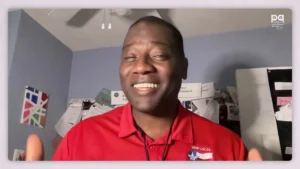Addressing Human Intuition Can Improve Workplace Safety Ahead of Active Shooter Situations
With the prevalence of mass shootings, growing concerns about active shooter situations are more pronounced than ever. Today it is critical that there is preparedness and continuous reassessment in case of a possible situation. But relying on outdated plans will undermine the very purpose of having a security protocol. There are physical security measures that have to be taken, along with surveillance and training that will expedite readiness. But there’s another layer often missed, which is human intuition.
Often when a tragic event unfolds, there’s someone who felt something was amiss. Keeping such potential threats like that on the radar could preemptively mitigate potential active shooter risks. Drawing upon this critical perspective is Kevin Davis, the Assistant Director of Public Safety at Harding University. He recently exhibited at the GSX 2023 to ask guests an important question; are you doing enough to prepare? Davis stressed the importance of proactive measures, routine updates, and the integration of evolving best practices at workplaces. He also discussed what areas can benefit from improvement.
Davis’ Thoughts on Active Shooter Situations
Importance of Testing Plans
“Testing the plans that you’ve got on paper to make sure what you have on paper will actually work.”
“And so if you never test your emergency operations plan or you never test your active shooter specific plan, you don’t know if it’s gonna fail at the wrong moment.”
“And so testing and training is essential.”
Mitigating Active Shooter Events
“So my presentation was on how to best mitigate and prepare for an active shooter event if it ever happened at your facility, whether it’s a school, hospital business factor, whatever your setting is, it’s to how best prepare for it in case the unthinkable happens.”
“We want to prevent a shooting situation from happening before it ever even comes to fruition.”
“Every time there’s a mass shooting that happens and you see it on the media, someone is interviewed and they say, I knew it was gonna be that person.”
Physical Security Measures
“Another thing, of course, is making sure your physical security is appropriate for the business that you’re trying to protect, it starts outside in.”
“Making sure your physical security program is up to par to help prevent even the intrusion of an active shooter to your facility.”
Training and Facility Knowledge
“The next thing is the training of your security team.”
“Make sure you have interoperability with law enforcement personnel as well, invite them to your facilities, help them train with your security personnel. Let them utilize your spaces for some of their training too.”
“We also wanna train all of your stakeholders within the business.”
“You either try to run away from it, hide away from it, or fight if you need to.”
“And so you wanna make sure that they train and are prepared as best they can.”
Communication during Emergencies
“I say it’s communicating to your people how and who initiates a lockdown or lets people know that there’s an active shooter there.”
“And so all the communication pieces are essential too to make sure that you’re as prepared as you can be at your business.”
Importance of Announced Drills
“I always tell everybody, though, you never ever do an announced drill or scenario or exercise ever, especially when it comes to active shooting.”
“So make sure that you’re planning accordingly.”
Good Intentions vs. Reality
“I think that all institutions have good intentions when it comes to accuracy or even really any emergency situation preparedness.”
“It needs to be a living, breathing document.”
“It needs to be reevaluated on a constant basis to make sure what’s in the plan actually reflects the practices that are out there right now for the business itself.”
“If you’re going to plan, planning is crucial, but make sure that plan’s a living document and you actually train to the most current version.”
Article written by Alexandra Simon.







